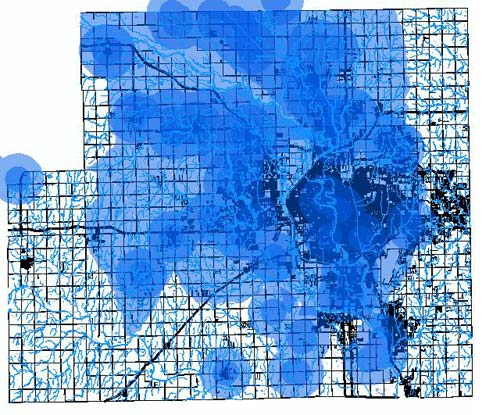The Non-Point Source Pollution Program continuously takes applications for septic replacement cost-share through the on-site waste program. Those with failed septic systems are eligible for up to $2,500 in cost-share assistance to replace an existing septic system. This program has limited funding and thus is targeted at the parts of Sedgwick County that are the most sensitive in terms of water quality. Funding is provided by the State Conservation Commission.
All applicants are ranked based on the water quality parameters of their property’s location. The criteria include the following: located within a TMDL watershed (watershed exceeding the total maximum daily load allowable for various pollutants), distance to a public water well, distance to a private water well, distance to a water body or stream, located in the Equus Beds. The following map of Sedgwick County shows the areas of priority in blue, with a deeper blue color indicating higher priority.

A waiting list of applicants is maintained until funds become available. Funds are then allocated to those individuals with the highest priority scores at the time the funding is received and processed. Funds are normally made available to the district in July and reallocated funds, if available at the state level, are received by the district in December each year.
This cost-share does not apply retroactively, thus, to qualify for the funds, an individual must be allocated funds by the SCCD prior to fixing the failed septic system components. Allocation is conferred by a signed contract between the individual and the State Conservation Commission as processed by the NPS coordinator.
The cost-share is not available to new septic system construction projects, nor does it assist in paying for connection to city sewer services.
Applicants who receive funding are required to pay for the installation costs in full prior to receiving the cost-share funds, thus must have the means to cover the initial cost. Occasionally an approved applicant is unable to pay for this installation, or unable to complete the installation within 60 days of the funds being made available. In those cases, the funds will then be reallocated to the next applicant on the waiting list.
How to apply for Cost-Share Assistance Programs through the Sedgwick County Conservation District:
Applications received January 1 through March 15 will be grouped and ranked first for possible funding on July 1.
Applications received March 16 through June 30 will be grouped and ranked for possible funding if funds remain available from the July 1 allocation.
Applications received July 1 through November 30 will be grouped monthly and ranked for possible funding monthly if funds remain available from the July 1 allocation.
Applications will not be accepted in December. All unfunded applications on file from January 1 through November 30 of current year will be notified in December of the new year application process which begins again in January. Unfunded applications are encouraged to apply in January and February for the best chance of receiving funds.
Non-Point Source (NPS):
- The landowner submits an application along with a W-9 to the Conservation District (CD).
- Applications are ranked, and letters of tentative approval are sent out on or after July 1.
- The landowner obtains estimates, selects a contractor, and the contractor obtains a permit from MABCD.
- The landowner or contractor submits the permit to the CD (within 2 weeks of receiving the tentative approval letter).
- A contract will be created by the District Manager and approved by the Sedgwick County Conservation District Board of Supervisors and the State Division of Conservation.
- The District Manager contacts the landowner by phone and/or mail when the contract is ready to sign.
- The landowner signs the contract.
- Work on the project can now begin.
- The County Sanitarian inspects the project and signs off on it. This final evaluation is submitted to the CD along with receipt(s) for payment in full.
- The District Manager requests payment from the State.
- Payment from the State is mailed to the landowner.